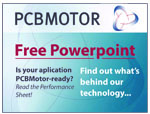The tracking controller, PIC16F684, is a microcontroller-based extension to our standard driver. The controller adjusts the frequency for maximum current, which gives optimum performance in the motor regardless of temperature and voltage. When power is applied, the controller turns on the motor and makes an initial frequency sweep to find/store the resonance frequency. The motor […]
How to driver Motors in parallel?
Driver two motors with same driver It is fine to drive two motors in parallel on the same output stage as long as they have the same resonance frequency. So if you use motors (same size) and from the same batch and you should be ok, since the frequencies are very close. Motor produced on […]
Interface to High Resolution Twin Controller
The USB chip has 4 CMOS inputs (CTS, DSR, RI CD) and one CMOS output (RTS) that can be controlled independently of the motor. These lines are available at the edge of the driver board as small test pads and with care it is possible to solder wires to these lines although it is not […]
What is the cost of a control driver for larger volumes?
The most expensive components in the driver are the transformers. In large volumes >100ku the transformer price will be app. 0.80 EUR each – each driver needs two transformers. The price is not negotiated, so it might be possible to drive the cost down even further. The remaining components for the driver will be at […]
What’s the lifetime of a PCBMotor?
The lifetime is related to the wear of the friction tape. A lifetime test over 666 hours has shown no indication of performance degradation or wear of friction tape. A lot of friction tape remained intact at the end of the test, indicating an expected lifetime of 1000 hours or more.
Are there any options if I need a smaller control driver footprint?
Yes. The transformers we use in our control drivers can handle the power requirements for our full motor range. When dealing with the smaller versions of PCBMotors, there is room for optimization of the transformer size. This requires careful redesign, as the transformers – apart from stepping up the voltage – also act as inductors […]
Can I expect EMC issues wth the control driver and motor?
No, the control driver is working at fairly low frequencies (40kHz and 160kHz) and furthermore the stator is operating at resonance and therefore the content of higher harmonics will be low. We’ve done some preliminary EMC-testing with the present layout of the driver. Customers have done the necessary optimization including additional decoupling and shielding to […]
Can a PCBMotor, control driver and application circuit be mounted on the same PCB?
Yes. The PCBMotor, the control driver and your application circuit can be mounted on the same PCB if you want to. See the images on Our product gallery
Can several PCBMotors be controlled by the same driver?
Yes, one central driver can drive several motor positions by multiplexing. These boards are examples of designs with several motors driven by same control driver. We have had customer design with more than 40 motors in one design. The motors can be on same board or on different boards. To save space multiple motors can […]
What supply voltage do the driver need?
The control driver is supplied with nominally +5V used for the driver circuitry and for the motor supply. A voltage regulator can set the motor supply to anywhere between the +5V and 0V. Maximum rotating speed and torque is achieved at +5V. Lowering the motor supply will lower the rotating speed (and torque). How low […]
Do I have to purchase the control driver from PCBMotor?
No. We’re happy to provide you with the full schematic, BOM and white papers enabling you to design and manufacture your own control driver. However, if you prefer we are also happy to do this for you.
Why do I need frequency tracking?
The rotating force is achieved by exciting the piezo elements on the stator in a pattern that generates a traveling wave. This wave makes the rotor rotate. To get the maximum wave amplitude, and thereby maximum torque, the stator has to vibrate at its mechanical resonance frequency. This is around 45 kHz, but varies with […]
What does the control driver do?
The driver is controlled via two input pins, one for turning power ON/OFF, and another for selecting direction CW/CCW. When turned ON, the control driver converts the motor supply voltage Vs of up to +5V into two square wave signals at around 45 kHz, shifted 90 degrees. Two transformers step up the voltages to around […]


